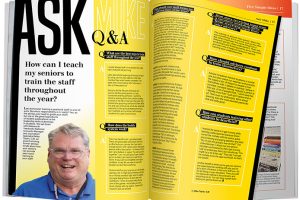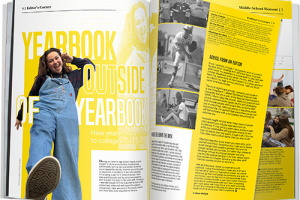Getting ready for the new year
12 Steps to smooth sailing
As yearbook adviser, you are the captain of a ship setting out for a one-year voyage with an inexperienced crew. If you have been on this trip before, you know about the rough waters ahead. It is likely you have already begun to prepare. However, if this is your maiden voyage, you probably are not sure what to expect.
The entire school is standing on the shoreline waving good-bye, confident you will return in a few months with a spectacular shipment of yearbooks. Although no one in this crowd of well wishers has a clue about how you can reach this destination, they have plenty of expectations for the product you will deliver to them next spring or fall.
So how do you pull off this miraculous feat and satisfy all the folks back home when you are not really sure where you are going and how to get there? The answer is simple but not painless. You must plan the trip carefully at the beginning, commit the plan to paper and constantly refer to it to make sure you stay on course. Without a solid plan, you and your staff are in danger of getting lost or going under before reaching your final destination.
Make no mistake- there is only one place you want to be at the end of this adventure, and that is delivering an on-time, on-budget yearbook that accurately and completely records the memories and events of the school year.
As you sit down to chart your course, consider each of these 12 steps to smooth sailing.
1. Map a course together
Make sure you, your principal and your staff are looking at the same map. If the principal believes the yearbook should immortalize the football team, while you are planning to slash varsity gridiron coverage from 12 pages to four, you are not looking at the same map. Before making detailed plans, study the yearbooks from previous years, talk to the principal about his or her expectations, seek input from your staff, poll the student body and familiarize yourself with the yearbook judging criteria published by the National Scholastic Press Assoc-iation and Columbia Scholastic Press Association.
To avoid detours and disappointment, your plan for the book must be a shared vision. If not everyone at your school wants a journalistically sound yearbook, then you have a lot of teaching and communicating to do, as well as some compromising.
2. You are not alone
If this is your first time serving as yearbook captain, find experienced people to act as guides. Seek out and befriend the former yearbook adviser, advisers at surrounding schools, your Walsworth sales and customer service representatives, photo processors, school photographers, and computer support personnel. Print their names, mailing addresses, home and work phone numbers, e-mail addresses, and fax numbers on bright paper that can be posted in numerous locations. Keep a copy in your organizer and wallet too. These people are lifelines when those million dollar questions present themselves.
3. Stock up
Complete an inventory of your equipment and supplies, and stock up for the year. Once you set sail, you will be busy training deck hands on the computers, coping with sudden changes in events and making sure the yearbook stays on course. Running out of film at the same time a rainbow appears on the horizon is annoying and unnecessary. It is better to anticipate the equipment, film, toner cartridges and other supplies you will need by reviewing purchase orders from the previous year.
4. Keep a Captain’s log
Fill a large binder with sections for essential information about your school and the detailed decisions you make during the year. For example, you need to know how many freshmen are enrolled before deciding how many pages to include in the people section, so it is important to ask the office for copies of the class rosters.
5. Make essential decisions early
Final decisions about book size, number of pages, color placement, number of copies, portrait photography, cover and endsheet design, ad and book sales prices, budget, and page submission deadlines cannot be delayed. Numerous production steps are affected by these decisions and procrastination is a sure way to sink your ship from the start.
Plan a lengthy meeting with your sales representative early in the year to nail down these details. If you do not have enough information to make these decisions, get the facts needed without delay and be sure your decisions are communicated and recorded to everyone involved in the process.
Let the portrait photographers know in writing when the mugs are needed and what size they need to be, give the front office the deadlines for retake photos, and finalize with your sales representative the cover and endsheet specifications.
Inform students and parents of deadlines that affect them. Keep your sales and customer service representatives informed through both phone calls and written correspondence, especially when making changes in book specifications. Remember that adding more than 16 pages to the book requires the size of the spine to be enlarged.
6. Organize for efficiency
If you want to get good mileage during the school day, your classroom needs to be in shipshape. As the captain of this voyage, there are more important things to do than locate and put away supplies and answer endless questions such as how to spell a teacher’s name or find a room number.
Supplies used during the production cycle or information that will be repeatedly referred to during the year should be stored in designated locations which are clearly labeled. Materials such as floppy disks, rulers, wax pencils, scissors, and photo labels should be easily accessible to the staff. Plastic storage drawers are great for organizing small supplies. Sturdy binders should be used for class rosters, ad contracts and completed layouts. Bulletin boards are also useful for displaying deadlines and section designs. Have section editors write type specs on the back of a sample spread, then laminate it and post it in the room for future reference.
Failure to put away supplies at the end of a class period should be viewed as a serious crime equal to treason. Consider appointing a class secretary who can police staff members who have not yet realized that their mothers are not there to pick up their messes. Rigid expectations for neatness and order at the beginning of the year will pay off immensely as the year progresses.
7. Create a master plan
Complete a detailed ladder, theme packet and deadline schedule as soon as possible. This master plan, which should be completed no later than six weeks after school starts, should include more than just the story concept for each spread. It should include suggested sources, questions to ask sources, specific sidebar ideas, photo possibilities, type and graphic specs, a mockup or computer printout of each section design, deadlines for each step of the production process as well as the writer, designer and photographer assigned to each job.
The editor and adviser should make decisions about page allotment, making sure that color falls within the same flat and that each class, club and sport within the school gets fair coverage. However, the entire staff, divided into teams, should complete the detailed planning involved in the yearbook. The more familiar the staff is with the plan, the better they will be at carrying it out.
8. Select your crew carefully
Start with the premise that everyone on board is vitally important to the success of the mission. After identifying all the tasks that need to be completed, divide the work into various job descriptions with specific duties. Give everyone on the staff a specialized job description that matches his or her interests, talents and personality.
Be generous with titles. Even the newcomers need something more than “staff member” written by their names. Jobs such as morale manager (the person who plans staff parties and recognizes birthdays) and class secretary (the roll taker and record keeper) are important and necessary.
Keep in mind that you may need to revise the job descriptions from year to year to fit the strengths of individual staff members. Also, make sure that all staff members understand they will write stories or captions, take photos and sell ads, some more than others depending upon their job descriptions.
9. Establish expectations
A staff handbook containing lists of rules, procedures, rubrics, how-to lists, job descriptions, deadlines, photo guidelines, human relation tips, design checklists, etc. can be helpful in letting students know what is expected.
Keep samples of quality writing, design and photography in front of students as much as possible, and find subtle ways to recognize quality work produced by staff members. This might include displaying the student’s work on a bulletin board or placing a candy bar with a note in staff boxes. Be careful about overpraising select staff members in front of the class because it generally creates resentment and jealously. Taking a student aside to give personal praise or correction, however, can be beneficial and powerful.
When checking student work, use short, specific comments, stickers and checklists to let staffers know what is good about their work and what they need to do to improve it. If there are quotas for book sales and ad sales, post individual and staff progress charts in the room. No one on the staff wants to be the person lagging behind. At the beginning of each deadline, have the editors list the pages that are due on a large chart and check off each phase of production.
10. Continuously train your crew
The yearbook class is a learn-as-you-go exper-ience, but that does not mean it is not a ÒrealÓ class. Early in the year, identify the essential concepts and skills that students should master and plan a way to present this information in mini-lessons throughout the year. Perhaps one day a week should be reserved for teaching and reviewing basic concepts such as journalism ethics, filling out a book order, interviewing, handling quotes, photo composition, typography, text wrapping, etc.
Keep the lessons short and practical, but make it clear that the information presented will appear on semester exams. Bright students will pick up on many skills and concepts through experience only, but most need a more structured presentation to make the lessons stick. Walsworth’s In Print textbook for yearbook journalism is a good starting point.
11. Celebrate each new passage
When planning the deadline schedule at the beginning of the year, be sure to pencil in morale-building activities after each major deadline. It is easy to overlook this important step if you do not think about it ahead of time. Celebrate with pizza parties, movie nights, cupcakes, a day off to play games on the computers, a whole class period to take a nap – anything you can think of to say, “You worked hard and are appreciated. You deserve a break before we start on the next deadline.” To prevent misunderstandings, communicate these motivational strategies to the administration in advance.
12. Evaluate progress along the way
Every experienced yearbook adviser will agree there has never been a perfect yearbook. However, that does not mean we should stop trying to create it. In the quest for perfection, write down mistakes or ideas for improvement as soon as they pop into your head. Ask staff members to present solutions to the problems they encounter. When planning the next yearbook journey, you will be reminded of the trouble spots and your chances for smooth sailing will greatly increase.




2 Comments
This is our school’s first attempt at a yearbook. Our School is having its 50th year next year. We would need all the help and encouragement available.Thanks
Thank You